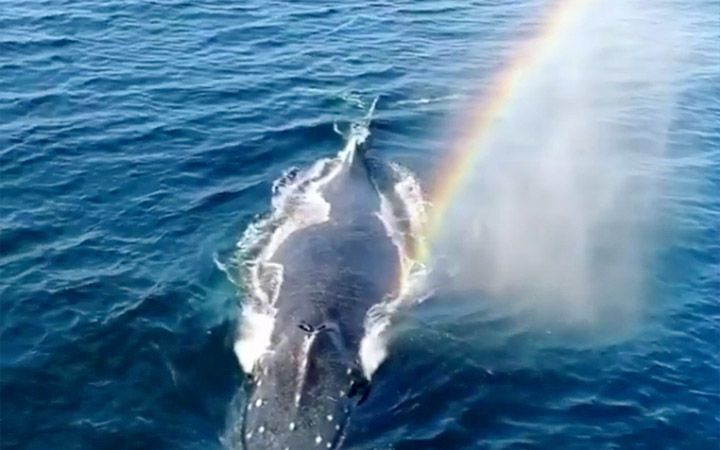Whale Sneezes Rainbow, Proving Nature is Beautiful and Weird
They say that at the end of every rainbow is a humpback whale.
Wait, do they say that? Regardless — thanks to a California wildlife photographer with impeccable timing, you can now say with certainty that at the end of at least one rainbow, there is at least one humpback whale. Watch the glorious, light-spouting cetacean seemingly sneeze a rainbow out of its blowhole in the Instagram video above.
Wildlife photographer Domenic Biagini caught this footage while on a whale-spotting excursion near San Diego last December. (The Instagram feed of Biagini, a photographer for Captain Dave's Dolphin & Whale Watching Safari, is loaded with breathtaking videos of whales and dolphins.) Biagini posted the clip to Reddit yesterday (April 10), and the footage has since amassed more than 26,000 "upvotes." [Whale Album: Giants of the Deep]
That's a lot of love for luminous whale boogers. Whales are oxygen-breathing mammals that happen to live in the sea; the blowholes at the tops of their heads are, basically, giant nostrils. Whales use these nostrils just like you do when you swim: to suck in air at the water's surface and to exhale old air when it's time for a fresh breath. The waterspout you see in the video above comes from this exhalation — but the spout is not all water. Whales typically exhale a mixture of air (warmed by the whale's body), some water vapor and plenty of whale snot.

In Biagini's video, the vapor in the whale's exhalation just happened to catch the sunlight the same way raindrops do when they refract light into its constituent colors, creating rainbows. Like all rainbows, it's a play of light unique to the eyes of the observer; if Biagini had been filming from a different angle relative to the sun, he probably wouldn't have seen the same rainbow effect.
Even if you never see a whale sneeze a rainbow in person, let this video serve as a reminder that humpback whales are totally awesome. These whales are thought to migrate farther than any other mammal on Earth, traveling up to 6,000 miles (9,800 kilometers) in a single season. They sing love songs that obey the rules of grammar, forge long-lasting friendships, and may even try to save your life when sharks (and bloodthirsty orcas) are nearby. All that said, these whales' giant placentas are pretty gross.
Originally published on Live Science.
Sign up for the Live Science daily newsletter now
Get the world’s most fascinating discoveries delivered straight to your inbox.

Brandon is the space/physics editor at Live Science. His writing has appeared in The Washington Post, Reader's Digest, CBS.com, the Richard Dawkins Foundation website and other outlets. He holds a bachelor's degree in creative writing from the University of Arizona, with minors in journalism and media arts. He enjoys writing most about space, geoscience and the mysteries of the universe.









